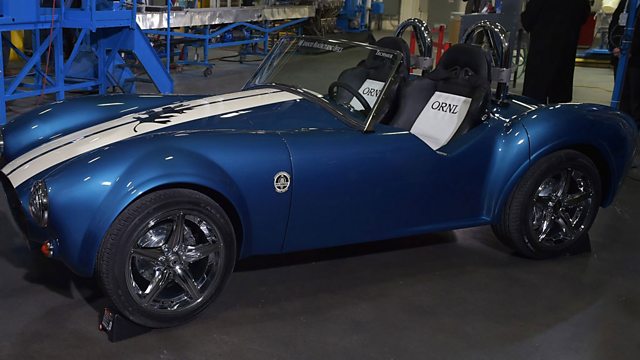Scientists 3D Print Cars
Scientist 3D print cars, Faster 3D printing, Farming African wet savannah, The Large Hadron Collider at CERN is about to be switched back on after a two-year upgrade
Scientists have 3D printed a replica of a vintage 1965 Shelby Cobra sports car to showcase this rapid prototyping technology. The team at the Oak Ridge National Laboratory (ORNL) took only six weeks from start to finish. The car is not just to show that there is more than one way to make a car. The team are using the vehicle as a rolling laboratory for testing automotive technology, where new power plants, fuel cells, electronics, and other systems can be installed.
Faster 3D Printing
One method of 3D printing, stereo-lithography – uses high-energy lasers to solidify special liquid polymers to build up layers of the 3D object. However the process is quite slow, as each layer needs to be peeled off a supporting glass plate, before the next thin layer can be produced and the presence of oxygen can mess up the process. But a new technique – called CLIP – Continuous Liquid Interface Production, does away with the glass plate and the time consuming layer by layer aspect and makes a virtue of oxygen to level off each layer. This means they can virtually play a laser video of the required structure and ‘pull’ the finished object from the liquid polymer. The team from UNC Chapel Hill claim this can speed up the process up to 100 times and makes much smoother objects.
Farming African Wet Savannah
The global population is estimated to rise to 9.2 billion in 2050, and to feed us all, it has been calculated that we will need 70% more food production. The need to find more sustainable sources of food has led governments and intergovernmental groups such as the World Bank, the Food and Agriculture Organisation of the UN and even the Intergovernmental Panel on Climate Change to look for supplementary, and alternative, regions to grow crops, both for food and biofuels. One type of habitat that is getting a lot of focus, and is assumed to be suitable is wet savannah, particularly those in Africa. But these habitats, with their sufficient rainfall and lack of dense cover, argues Tim Searchinger in Nature Climate Change this week, are not a low environmental cost solution for converting to cropland. Based on new studies, he estimates only 2% of these areas would be suitable for growing maize with carbon levels less than the average and that the threat to biodiversity is another reason for the world’s leaders to seek alternative sources of food.
Switching the LHC Back On
Finally, it is back - bigger, hotter and ready for some smashing physics. CERN says that next week, the largest single machine in the world gets plugged in, switched on, and rebooted, after a two-year rest. The Large Hadron Collider was crashing particles together at almost the speed of light, and in doing so, simulating the universe fractions of a second after the Big Bang. And the data generated revealed, amongst many other things, the Higgs Boson.
The LHC has had a well-earned break, been cleaned and repaired, and an upgrade, and will be shortly achieving energies twice as great as before.
(Photo: A 3D printed Shelby Cobra © MANDEL NGAN/AFP/Getty Images)
Presenter: Jack Stewart
Producer: Fiona Roberts
Last on
More episodes
Previous
Chapters
-
3D Printed Cars
Scientists have 3D printed a replica of a vintage 1965 Shelby Cobra sports car
Duration: 04:40
Faster 3D Printing
A new technique in stereo-lithographic 3D printing has speeded up the process
Duration: 07:49
Farming African Wet Savannah
Should we grow crops on Africa’s wet savannahs?
Duration: 07:26
Switching the LHC Back On
The Large Hadron Collider at CERN is about to be switched back on after a two year upgrade
Duration: 05:37
Broadcasts
- Thu 19 Mar 2015 19:32GMTÂ鶹ÊÓƵAV World Service Online
- Fri 20 Mar 2015 00:32GMTÂ鶹ÊÓƵAV World Service Online
- Fri 20 Mar 2015 04:32GMTÂ鶹ÊÓƵAV World Service Online
- Fri 20 Mar 2015 13:32GMTÂ鶹ÊÓƵAV World Service Online
Podcast
-
![]()
Science In Action
The Â鶹ÊÓƵAV brings you all the week's science news.


